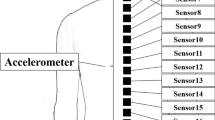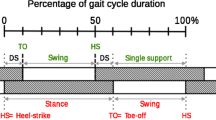Abstract
Piezoresistive accelerometer signals fre frequently used in movement analysis. However, their use and interpretation are complicated by the fact that the signal is composed of different acceleration components. The aim of the study was to obtain insight into the components of accelerometer signals from the trunk and thigh segments during four different sit-to-stand (STS) movements (self-selected, slow, fast and fullflexion). Nine subjects performed at least six trials of each type of STS movement. Accelerometer signals from the trunk and thigh in the sagittal direction were decomposed using kinematic data obtained from an opto-electronic device. Each acceleration signal was decomposed into gravitational and inertial components, and the inertial component of the trunk was subsequently decomposed into rotational and translational components. The accelerometer signals could be reliably reconstructed: mean normalised root mean square (RMS) trunk: 6.5% (range 3–12%), mean RMS thigh: 3% (range 2–5%). The accelerometric signals were highly characteristic and repeatable. The influence of the inertial component was significant, especially on the timing of the specific event of maximum trunk flexion in the accelerometer signal. The effect of inertia was larger in the trunk signal than in the thigh signal and increased with higher speeds. The study provides insight into the acceleration signal, its components and the influence of the type of STS movement and supports its use in STS movement analysis.
Similar content being viewed by others
References
Arborelius, U. P., Wretenberg, P., andLindberg, F. (1992): ‘The effects of armrests and high seat heights on lower-limb joint load and muscular activity during sitting and rising’,Ergonomics,35, pp. 1377–1391
Bussmann, J. B., andStam, H. J. (1998): ‘Techniques for measurement and assessment of mobility in rehabilitation: a theoretical approach’,Clin. Rehabil.,12, pp. 455–464
Bussmann, J. B., Reuvekamp, P. J., Veltink, P. H., Martens, W. L., andStam, H. J. (1998a): ‘Validity and reliability of measurements botained with an “activity monitor” in people with and without a transtibial amputation’,Phys. Ther.,78, pp. 989–998
Bussmann, J. B., Tulen, J. H., Van Herel, E. C., andStam, H. J. (1998b): ‘Quantification of physical activities by means of ambulatory accelerometry: a validation study’,Psychophysiology,35. pp. 488–496
Bussmann, J. B., Van De Laar, Y. M., Neeleman, M. P., andStam, H. J. (1998c): ‘Ambulatory accelerometry to quantify motor behaviour in patients after failed back surgery: a validation study’,Pain,74, pp. 153–161
Bussmann, J. B., Damen, L., andStam, H. J. (2000): ‘Analysis and decomposition of signals obtained by thigh-fixed uni-axial accelerometry during normal walking’,Med. Biol. Eng. Comput.,38, pp. 632–638
Bussmann, J. B., Martens, W. L., Tulen, J. H., Schasfoort, F. C., Van Den Berg-Emons, H. J., andStam, H. J. (2001): ‘Measuring daily behavior using ambulatory accelerometry: the Activity Monitor’,Behav. Res. Methods Instrum. Comput.,33, pp. 349–356
Gross, M. M., Stevenson, P. J., Charette, S. L., Pyka, G., andMarcus, R. (1998): ‘Effect of muscle strength and movement speed on the biomechanics of rising from a chair in healthy elderly and young women’,Gait Posture,8, pp. 175–185
Hughes, M. A., andSchenkman, M. L. (1996): ‘Chair rise strategy in the functionally impaired elderly’,J. Rehabil. Res. Dev.,33, pp. 409–412
Janssen, W. G., Bussmann, H. B., andStam, H. J. (2002): ‘Determinants of the sit-to-stand movement: a review’,Phys. Ther.,82, pp. 866–879
Kerr, K. M., White, J. A., Barr, D. A., andMollan, R. A. B. (1994): ‘Standardization and definitions of the sit-stand-sit movement cycle’,Gait & Posture,2, pp. 182–190
Kerr, K. M., White, J. A., Barr, D. A., andMollan, R. A. B. (1997): ‘Analysis of the sit-stand-sit movement cycle in normal subjects’,Clin. Biomech.,23, pp. 236–245
Kralj, A., Jaeger, R. J., andMunih, M. (1990): ‘Analysis of standing up and sitting down in humans: definitions and normative data presentation’,J. Biomech.,23, pp. 1123–1138
Mathie, M. J., Coster, A. C., Lovell, N. H., andCeller, B. G. (2004): ‘Accelerometry: providing an integrated, practical method for long-term, ambulatory monitoring of human movement’,Physiol. Meas.,25, pp. R1–20
Mayagoitia, R. E., Nene, A. V., andVeltink, P. H. (2002): ‘Accelerometer and rate gyroscope measurement of kinematics: an inexpensive alternative to optical motion analysis systems’,J. Biomech.,35, pp. 537–542
Moe-Nilssen, R. (1998): ‘A new method for evaluating motor control in gait under real-life environmental conditions. Part 2: Gait analysis’,Clin. Biomech.,13, pp. 328–335
Moe-Nilssen, R., andHelbostad, J. L. (2002): ‘Trunk accelerometry as a measure of balance control during quiet standing’,Gait Posture,16, pp. 60–68
Mourey, F., Pozzo, T., Rouhier-Marcer, I., andDidier, J. P. (1998): ‘A kinematic comparison between elderly and young subjects standing up from and sitting down in a chair’,Age Ageing,27, pp. 137–146
Mourey, E., Grishin, A., D'athis, P., Pozzo, T., andStapley, P. (2000): ‘Standing up from a chair as a dynamic equilibrium task: a comparison between young and elderly subjects’,J. Gerontol. A Biol. Sci. Med. Sci.,55, pp. B425–431
Najafi, B., Aminian, K., Loew, F., Blanc, Y., andRobert, P. A. (2002): ‘Measurement of stand-sit and sit-stand transitions using a miniature gyroscope and its application in fall risk evaluation in the elderly’,IEEE Trans. Biomed. Eng.,49, pp. 843–851
Najafi, B., Aminian, K., Paraschiv-Ionescu, A., Loew, F., Bula, C. J., andRobert, P. (2003): ‘Ambulatory system for human motion analysis using a kinematic sensor: monitoring of daily physical activity in the elderly’,IEEE Trans. Biomed. Eng.,50, pp. 711–723
Schenkman, M., Berger, R. A., Riley, P. O., Mann, R. W., andHodge, W. A. (1990): ‘Whole-body movements during rising to standing from sitting’,Phys. Ther.,70, pp. 638–651
Slagter, A. H., Bussmann, H. B., Wagenaar, R. C., Van Der Cammen, T. J., andStam, H. J. (1998): ‘Quantifying quality of moving in the elderly based on ambulatory accelerometry’,Stud. Health Technol. Inform.,48, pp. 249–253
Van Den Berg-Emons, H. J., Bussmann, J. B., Balk, A. H., andStam, H. J. (2000): ‘Validity of ambulatory accelerometry to quantify physical activity in heart failure’,Scand. J. Rehabil. Med.,32, pp. 187–192
Van Den Berg-Emons, H. J., Bussmann, J. B., Balk, A. H., Keijzer-Oster, D., andStam, H. J. (2001a): ‘Level of activities associated with mobility during everyday life in patients with chronic congestive heart failure as measured with an “activity monitor”,Phys. Ther.,81, pp. 1502–1511
Van Den Berg-Emons, H. J., Bussmann, J. B., Brobbel, A. S., Roebroeck, M. E., Van Meeteren, J., andStam, H. J. (2001b): ‘Everyday physical activity in adolescents and young adults with meningomyelocele as measured with a novel activity monitor’,J. Pediatr.,139, pp. 880–886
Vander Linden, D. W., Brunt, D., andMcculloch, M. U. (1994): ‘Variant and invariant characteristics of the sit-to-stand task in healthy elderly adults’,Arch. Phys. Med. Rehabil.,75, pp. 653–660
Author information
Authors and Affiliations
Corresponding author
Rights and permissions
About this article
Cite this article
Janssen, W.G.M., Bussmann, J.B.J., Horemans, H.L.D. et al. Analysis and decomposition of accelerometric signals of trunk and thigh obtained during the sit-to-stand movement. Med. Biol. Eng. Comput. 43, 265–272 (2005). https://doi.org/10.1007/BF02345965
Received:
Accepted:
Issue Date:
DOI: https://doi.org/10.1007/BF02345965




